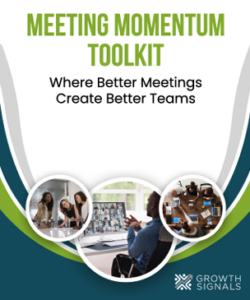Are you seeing signs of burnout in your employees, such as decreased productivity, engagement, or morale?
If so, you’re not alone. Employee burnout is a growing concern in today’s fast-paced work environment, and it’s crucial to address it to ensure the wellbeing and productivity of your team.
In this post, we’ll explore how building resilience in your employees can help your organization prevent and recover from employee burnout, giving you practical strategies to create a positive work environment and support your team’s mental health.
So, are you ready to tackle burnout head-on and empower your team with resilience?
If so, read on.
Signs and Symptoms of Employee Burnout
Burnout is a state of emotional, physical, and mental exhaustion that can occur when individuals feel overwhelmed, stressed, and emotionally drained by their work.
Here are some signs and symptoms of burnout that you can look out for in your employees:
Decreased Productivity
Burnout can lead to a decrease in productivity as individuals may find it difficult to focus and complete tasks efficiently.
Disengagement
Employees who are burnt out can become disengaged from their work and the organization.
They may lose interest in their job and feel a lack of motivation to perform their duties.
Physical and Emotional Exhaustion
Burnout can cause individuals to feel physically and emotionally exhausted.
They may feel drained and depleted, lacking energy and enthusiasm.
Negative Attitudes
It can cause employees to develop negative attitudes towards their work and colleagues.
They may become cynical and critical, and their communication may become hostile or sarcastic.
Decreased Job Satisfaction
Burnout can lead to a decrease in job satisfaction as individuals may begin to question the value and purpose of their work.
Factors Contributing to Employee Burnout
Employee burnout can stem from various factors related to the work environment and the job itself.
Here are some common contributors:
Heavy Workloads
Employees may feel overwhelmed and stressed out when they have too much work to handle.
This can lead to a lack of motivation and productivity, as well as decrease the amount of time employees have for rest & recovery.
Long Hours
Working overtime or consistently long hours can cause exhaustion and leave employees with little time for self-care.
Lack of Control Over Work
Employees who feel like they have little autonomy over their work may experience a sense of disempowerment, leading to feelings of frustration and detachment.
Poor Work-Life Balance
When work takes up a significant amount of time and energy, employees may feel like they’re neglecting other important areas of their life, such as family, hobbies, or self-care.
Unrealistic Expectations
Employees may feel pressured to meet unrealistic deadlines or targets, leading to a sense of failure and inadequacy.
Poor Workplace Communication
When employees don’t feel like they can have open and honest conversations with their managers, minor stressors can add up and become a much larger problem, leading to employee burnout.
As a leader, it’s important to be aware of these contributing factors and take steps to address them in order to prevent burnout among your employees.
In the next section, we’ll explore how building resilience can help employees cope with and overcome these challenges.
The Importance of Resilience in Preventing or Recovering from Burnout
Stressful circumstances at work are unavoidable, but employees who are resilient are better equipped to handle stress and bounce back from difficult situations.
Resilience can help prevent burnout by allowing employees to manage their emotions, maintain a positive outlook, and adapt to change.
Additionally, building resilience can help employees recover from burnout.
Resilient employees are better able to bounce back from setbacks and cope with stress, helping them to avoid prolonged periods of emotional and physical exhaustion.
Strategies for Building Resilient Employees
Building resilient employees requires intentional effort, but it can be achieved through various strategies.
Here are some practical steps you can take to support your employees in building resilience and preventing burnout:
Encourage Rest and Recovery
Building microbreaks into the workday, avoiding off-hours communication, and encouraging employees to use their vacation time are ways to support rest and recovery.
Foster a Growth Mindset
Create opportunities for professional development and provide resources for continuous learning.
If something doesn’t work out as planned, schedule a debrief to identify the lessons learned and how you’ll apply them moving forward.
Promote Relationship Building
Get to know the people you work with through connection questions at the start of meetings, highlighting individual employee stories, and encouraging employees to share some aspects of their personal lives.
Maintain Clear & Consistent Communication
Our brains work to constantly try to predict what’s coming next.
When we can’t predict what’s next, our brains use considerably more resources to process everything around us.
Prioritize clear and consistent communication (even when you don’t have all of the answers).
Connect Employees to the Company’s Mission
Start company meetings with your mission statement, have leaders connect the mission to their team’s work, and most importantly, revisit and update your company’s mission statement at regular intervals.
Acknowledge and Make Space for Emotions
When an organization acknowledges and embraces all emotions, everyone wins.
By providing opportunities for continual listening and feedback, organizations can not only help build personal resilience but build trust, improve organizational efforts, and better define the emotional culture.
Get Your Employees Resilience Training
Resilience training helps employees develop the skills they need to manage stress and adversity, and to bounce back from setbacks.
By providing resilience training to your employees, you can help them cultivate the tools they need to prevent burnout and maintain their well-being.
Conclusion
Employee burnout is a serious issue that can have significant negative effects on individuals and organizations.
Building resilience in employees is one effective strategy for preventing burnout and promoting a healthy, productive work environment.
And the benefits of building resilience extend beyond just preventing burnout – resilient employees are also better able to handle setbacks, communicate effectively, and maintain positive relationships with colleagues.
By fostering a culture that values resilience and supports employees in building it, you can create a workplace that is not only more productive, but also healthier and more fulfilling for everyone.



